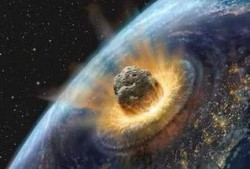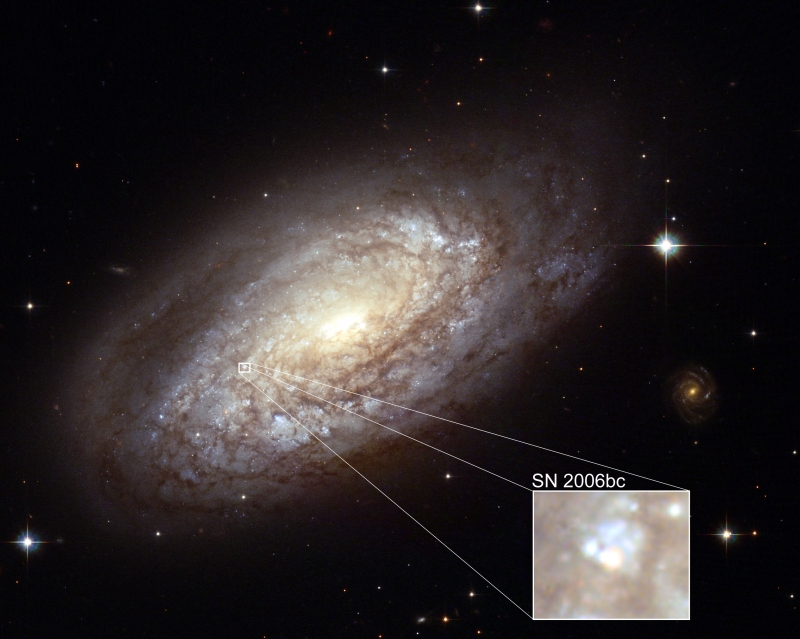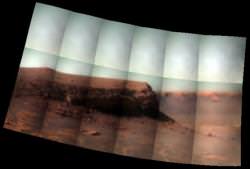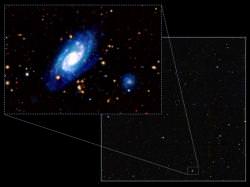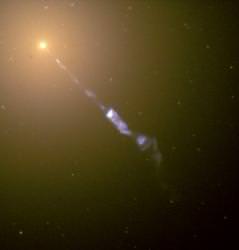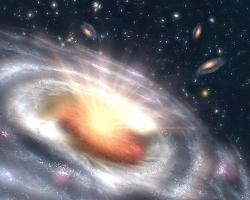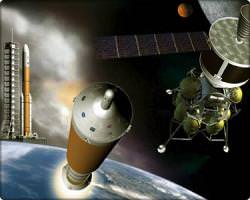Just one glimpse at this photo by Don Goldman tells a thousand words. Residing in the southern constellation of Ara, this incredible dust cloud is at home in Ara OB1 association, which covers a full degree of sky. Some 4000 light years away in the disk of our Galaxy, NGC 6188 sprawls across the edge of an expanding bubble of gas that could be as much as 300 light years wide.
Continue reading “Universe Today Astronomy Picture of the Week – NGC 6188: An Interstellar Portrait”
Hansen: Earth at Crisis Point
NASA’s lead climate scientist says Earth has reached a “tipping point†in the amount of carbon dioxide in the atmosphere at 385 parts per million. But James Hansen, director of NASA’s Goddard Institute for Space Studies believes there are ways to solve the problems of excess greenhouse gases in our atmosphere. Hansen submitted a paper to Science magazine today, which outlines a plan for phasing out all coal-fired plants by 2030 and taxing their emissions, as well as banning the building of any new plants unless they are designed to trap and segregate the carbon dioxide they emit. This plan would need the support of policy makers around the world. But Hansen believes policy makers in the US are ignorant about the significance and gravity of climate change because oil companies influence the executive and legislative branches of the US government. Oil interests are also trying to sway the public’s perception of global warming, Hansen said. “The industry is misleading the public and policy makers about the cause of climate change,†he said in an article published by the AFP news agency. “And that is analogous to what the cigarette manufacturers did. They knew smoking caused cancer, but they hired scientists who said that was not the case.”
Continue reading “Hansen: Earth at Crisis Point”
SkyWatcher Alert: Pleiades Occultation on April 8
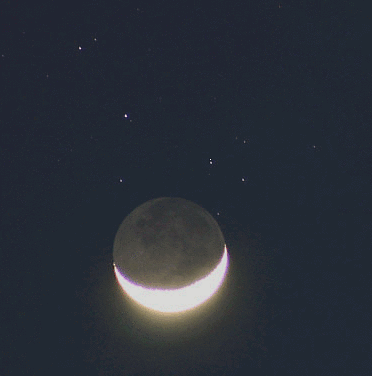 Sure. For those of us who hang around the night sky, we know the Pleiades and the Moon frequently venture near each other during the course of a year, but it’s much less common for the Moon to be in a crescent phase when they visit. Because the light of the nearby Moon often overpowers the cool, blue star cluster M45, SkyWatchers rarely have the opportunity to see the Moon sedately cover its stars. Not this time… Continue reading “SkyWatcher Alert: Pleiades Occultation on April 8”
Sure. For those of us who hang around the night sky, we know the Pleiades and the Moon frequently venture near each other during the course of a year, but it’s much less common for the Moon to be in a crescent phase when they visit. Because the light of the nearby Moon often overpowers the cool, blue star cluster M45, SkyWatchers rarely have the opportunity to see the Moon sedately cover its stars. Not this time… Continue reading “SkyWatcher Alert: Pleiades Occultation on April 8”
Meteorites Make a Big Splash on Mars: New Images of Secondary Craters by HiRISE
They look like pockmarks caused by shrapnel from a huge explosion. Actually they are surface features on Mars as seen by the High Resolution Imaging Science Experiment (HiRISE) on board the Mars Reconnaissance Orbiter (MRO). But what are they? They’re not potholes formed by geological processes, they’re not openings to ancient lava tubes, they are impact craters… but not like any impact crater you’ve seen before…

Most meteorite impact craters are roughly circular. If they are fairly new, ejected debris will be obvious emanating from the impact site. However, recent images by the HiRISE instrument appear to show tiny impact craters, in a swarm, each looking like they have been chiselled roughly out of the Martian regolith (pictured left).
The area of the image covers roughly 0.5×1.5 kilometres (25cm/pixel; features down 85cm can be resolved) of a large outflow channel in the Chryse Planitia region. The craters are actually secondary impact craters caused by large chunks of Martian rock being thrown up into the air after an energetic impact from a meteorite. To give an idea of size, the largest craters are about 40 meters across, a little smaller than an Olympic-sized swimming pool. It is not clear where the primary impact crater is in relation to the debris craters in the full-resolution image.
There appears to be dark material inside these small craters, possibly from the debris digging into layered deposits of different minerals just below the surface. Ripples of sand and dust are also evident. As these small craters are quite shallow, they will fill up and level out with wind-blown material quickly, so these secondary craters are fairly young when compared with geological timescales.
Source: HiRISE mission site
Did a Cooked Meteorite Seed Life on Earth?
Earth, four billion years ago, was a lifeless, hot and violent place. Not exactly a world where you’d expect life to form. But this was the scene where the first life-forming amino acids appeared. And how did this happen? According to new research, a lump of rock floating though space may have been irradiated by neutron star emissions, chemically altering amino acids hitching a ride on it. This rock then impacted the Earth and injected these altered chemicals into the desert wastes, possibly seeding the beginning of life on our planet… and this life was left-handed…
We’ve heard about this possibility before: life on Earth being seeded by some extra-terrestrial body, like a comet, meteorite or asteroid impact. In fact the prime reason for analysing comets and objects in the Oort Cloud (hovering around the outer reaches of our solar system) is to look for pre-life chemicals and organic compounds such as amino acids. Indeed, the discovery of organic compounds by the recent Cassini flyby of Saturn’s moon last month is another piece in the puzzle toward understanding the extent of life-giving chemicals on planets other than Earth.
Amino acids are a type of protein found in all life forms on Earth, it seems reasonable to search for the presence of these proteins on bodies other than our planet, possibly giving us more information about how life formed and where life came from.
There are two forms of amino acids, one left-handed and one right-handed, giving an indication of the orientation of the acid. For life to be seeded, these proteins must contain only one “chirality” (i.e. either left or right), it’s no good having mixed chirality.
At the 235th national meeting of the American Chemical Society, new research has been presented describing how our amino acid signature may have come from outer space. Ronald Breslow, a university professor at Columbia University points out that the vast majority of life on Earth has a “left chirality”. And his reason for this? The polarized light emitted from neutron stars many billions of years ago irradiated rocky bodies, with amino acid compounds on their surface, selectively destroying most of the “right-hand” acids. Although this theory may sound outlandish, it does give a possible reason for the prevalence of left-hand proteins in amino acids on Earth.
The irradiated meteorite will have impacted the Earth carrying amino acids with a dominance of left chirality which dropped into the “primordial soup”, evolving into the first forms of life. All life as we know it will have the same chirality as this soup of pre-biotic life.
“These meteorites were bringing in what I call the ‘seeds of chirality’ […] If you have a universe that was just the mirror image of the one we know about, then in fact, presumably it would have right-handed amino acids. That’s why I’m only half kidding when I say there is a guy on the other side of the universe with his heart on the right hand side.” – Ronald Breslow.
Breslow and his team simulated the events after such a meteorite hit the surface. As the left-hand dominated amino acids from space combined with existing amino acids (of mixed chirality) on Earth, the desert-like temperatures and a dash of water amplified the left-hand proteins, giving them dominance, thus sparking the basic building blocks of life. He argues that these acids were most likely brought to Earth via meteorite, and not chemically altered by radiation in-situ, “…the evidence that these materials are being formed out there and brought to us on meteorites is overwhelming,” said Breslow.
Source: Physorg.com
Supernova Precursor Discovered in Spiral Galaxy NGC 2397
It’s a bit like trying to find a needle in a haystack when looking for a star in a galaxy. Although hard to do, astronomers using images from the Hubble Space Telescope (HST) are doing just that, trying to find stars before they explode as supernovae. In 2006, supernova SN 2006bc was spotted in spiral galaxy NGC 2397, so astronomers got to work, sifting through previous images taken by the HST. They found that star, in the rising stage of brightness as it exploded. Usually we don’t get to see this stage of a supernova, as we can’t predict which star is going to blow. But retracing years of HST observational data, scientists are able to piece together the cosmic forensic evidence and see the star before it died…
SN 2006bc was seen in the spiral galaxy NGC 2397, located nearly 60 million light years from the Milky Way, back in 2006. There was no warning or any indication that that star was going to blow in that galaxy (after all, there’s a lot out there), but Hubble’s Advanced Camera for Surveys (ACS) captured the galaxy after it happened. So astronomers watched the afterglow of the event. While a lot of good science can be done by analysing the remnants of a supernova, wouldn’t it be great to see a star before it explodes? Perhaps then we can analyse the emissions from an unstable star before it dies…
Predicting cosmic events is no new thing, and much effort is being put into various forecasting techniques. A few examples include:
- Solar radiation: The main focus for solar physicists is to predict “space weather” to help protect us against the dangerous onslaught of high energy particles (particularly solar flares).
- Detecting supernova neutrinos: An “early warning” system is already in place to detect the neutrinos that are blasted from a star’s core at the moment of a star’s collapse (leading to a supernova). The SuperNova Early Warning System (SNEWS) has been set up to detect these neutrinos.
- Gamma ray bursts (GRBs): The Polish “Pi of the Sky” GRB detector is an array of cameras looking out for optical flashes (or transients) in the night sky above the Chilean mountains. Combined with NASA’s Swift gamma ray observatory in orbit, the burst is detected, immediately signalling other observatories to watch the event.
The above examples usually detect the sudden event of a solar flare, GRB or surge of neutrinos right at the point of initiation. Fortunately for solar physicists, we have a vast amount of high-spatial and high-temporal resolution data about our closest star. Should a flare be launched, we can “rewind the tape” and see the location of flare initiation and work out the conditions before the flare was launched. From this, we are able to be better informed and possibly predict where the next flare will be launched from. Supernova astronomers aren’t so lucky. The cosmos is a big place after all, only a tiny proportion of the night sky has been observed in any great detail, and the chances that the same region has been imaged more than once at high resolution are few and far between.
Although the chances are slim, researchers from Queen’s University Belfast in Northern Ireland, led by Professor Stephen J. Smartt used Hubble Space Telescope (HST) images to “rewind the tape” before supernova SN 2006bc occurred. By confining their search for “pre-supernova” stars in local galaxies, there was a better chance of studying galaxies that have been imaged at high resolution and imaged more than once in the past. SN 2006bc turned out to be the perfect candidate.
The group has done this before. Of the six precursor stars discovered to date, Smartt’s team found five of them. From their analysis, it is hoped that the characteristics of a star before it dies can be worked out as the conditions for a supernova to occur is poorly understood.
After ten years of surveying, the group presented their discoveries of supernova precursor stars at this year’s National Astronomy Meeting 2008 in Belfast, last week. It appears that stars with masses as low as seven times the size of our Sun can explode as supernovae. They go on to hypothesise that the massive stars may not explode as supernovae and may just die through collapse and form as a black hole. The emission from such an event may be too faint to observe and the most energetic supernovae may be restricted to the smaller stars.
However, six supernova precursor stars are not a large number to make any big conclusions quite yet, but it is a big step in the right direction to better understand the mechanisms at work in a star just about to explode…
Source: ESA
Carnival of Space #48
Slightly delayed, but the Carnival of Space is here again. This week, it’s hosted over at Next Big Future, with entries on dusty red dwarfs, classic science fiction movies and the trouble with telling the difference between Mars and Arizona.
Click here to read the Carnival of Space #48
And if you’re interested in looking back, here’s an archive to all the past carnivals of space. If you’ve got a space-related blog, you should really join the carnival. Just email an entry to [email protected], and the next host will link to it. It will help get awareness out there about your writing, help you meet others in the space community – and community is what blogging is all about. And if you really want to help out, let me know if you can be a host, and I’ll schedule you into the calendar.
Finally, if you run a space-related blog, please post a link to the Carnival of Space. Help us get the word out.
UK “Time Machine” Reveals The Formation Of Distant Galaxies
If you thought the Hubble Deep Field galaxy photo was the most incredible thing you’ve ever seen, wait until you lay eyes on the most sensitive infrared map of the distant Universe ever taken. Over the last three years, UK astronomers have compiled data from the United Kingdom Infrared Telescope (UKIRT) in Hawaii and their results are nothing less than astounding.
Today, Dr. Sebastien Foucaud from the University of Nottingham presented his first results to the April 4 National Astronomy Meeting of the Royal Astronomical Society. These results only form part of the Ultra-Deep Survey (UDS) – an image containing over 100,000 galaxies over an area four times the size of the full Moon – and a look into the formation of the most distant galaxies yet witnessed.
The 3.8-metre (12.5-foot) UK Infrared Telescope (UKIRT) became a time machine as the world’s largest telescope dedicated solely to infrared astronomy began its Deep Sky Survey in 2005. Even now, the UDS image is but only one element of a five-part project. Due to the constraints of the speed of light, these observations allow astronomers to literally look back 10 billion years in time. The images that UKIRT produces see our Universe in its distant infancy, and the formation galaxies which date to back where we believe expansion began. The image is so large and so deep that thousands of galaxies can be studied at these early epochs for the very first time. Through the technological advance of infrared imaging, astronomers can now peer even further back in time, since light from the most distant galaxies is shifted towards redder wavelengths as it travels through the expanding Universe.
“I would compare these observations to the ice cores drilled deep into the Antarctic,” said Dr. Foucaud. “Just as they allow us to peer back in time, our ultra-deep image allows us to look back and observe galaxies evolving at different stages in cosmic history, all the way back to just 1 billion years after the Big Bang”.
One of the goals of the project is to further scientific understanding about the time frame in which rare, massive galaxies formed in the distant Universe. It is a puzzle that has simply remained unsolved. Says Dr. Foucaud: “We see galaxies 10 times the mass of the Milky Way already in place at very early epochs. Now, for the first time, we are sampling a large enough volume of the distant Universe to be able to see them in sufficient numbers and really pin down when they were formed.”
The UKIDSS Ultra-Deep Survey will, in time, give us a complete census of galaxy formation in the infrared. So far over one hundred thousand galaxies have been detected and the final image will be 100 times larger than any equivalent survey to date. Determining precise distances to faint galaxies is very difficult, requiring long hours of spectroscopy. For the faintest objects in the UDS survey this is often impossible. Instead, by using optical and infrared colors, astronomers are very effectively able separate distant galaxies from those which are nearby, and further separate them into those which are forming stars and those which are not. UKIDSS aims to discover the nearest object to the Sun (outside the solar system) as well as some of the farthest known objects in the Universe.
Does the Ultra-Deep Sky Survey images shed light on the great cosmological mystery? Only time – and distance – will tell. Professor Andy Lawrence, Principle Investigator of UKIDSS from the University of Edinburgh, said “As we keep taking images over the next few years, we will see ever more distant galaxies.”
Star Formation Extinguished by Quasars
According to new research, a galaxy with a quasar in the middle is not a good place to grow up. As active galactic nuclei (AGN) evolve, they pass through a “quasar phase”, where the accretion disk surrounding the central black hole blasts intense radiation into space. The quasar far outshines the entire host galaxy. After the quasar phase, when the party is over, it is as if there is no energy left and star formation stops.
AGN are the compact, active and bright central cores to active galaxies. The intense brightness from these active galactic cores is produced by the gravitationally driven accretion disk of hot matter spinning and falling into a supermassive black hole at the centre. During the lifetime of an AGN, the black hole/accretion disk combo will undergo a “quasar phase” where intense radiation is blasted from the superheated gases surrounding the black hole. Typically quasars are formed in young galaxies.
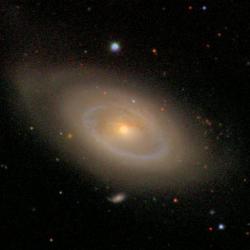
Although the quasar phase is highly energetic and tied with young galaxy formation, according to new results from the Sloan Digital Sky Survey, it also marks the end for any further star birth in the galaxy. These findings will be presented today (Friday 4th April) at the RAS National Astronomy Meeting in Belfast, Northern Ireland, by Paul Westoby having just completed a study of 360 000 galaxies in the local Universe. He carried out this research with Carole Mundell and Ivan Baldry from the Astrophysics Research Institute of Liverpool, John Moores University, UK. This study was proposed to understand the relationship between accreting black holes, the birth of stars in galactic cores and the evolution of galaxies as a whole. The results are astonishingly detailed.
By analysing so many galaxies, quite a detailed picture emerges. The primary result to come from this shows that as a young galactic core is dominated by a highly energetic quasar, star formation stops. After this phase in a galaxy’s life, star formation is not possible; the remaining stars are left to evolve by themselves.
It is believed that all AGNs go through the quasar phase in their early galactic lives. It is also thought that most massive galaxies will have a supermassive black hole hiding inside their galactic cores passively, having already gone through the quasar phase. Westoby notes that some dormant supermassive black holes can be “reignited” into a secondary quasar phase, but the mechanisms behind this are sketchy.
“The starlight from the host galaxy can tell us much about how the galaxy has evolved […] Galaxies can be grouped into two simple colour families: the blue sequence, which are young, hotbeds of star-formation and the red sequence, which are massive, cool and passively evolving..” – Paul Westoby.
It is found there is a sudden cut-off point for star formation, and this occurs right after the quasar phase. After the quasar phase, the AGN relaxes into a quieter state, there is no star formation and gradual evolution of stars progresses into the “red sequence” of star evolution.
Other findings include the indication that regardless of the size of the galaxy, it is the shape of the galactic “bulge” that matters. Without a large classical bulge in the centre, supermassive black holes that drive the AGN are not possible. Therefore, only galaxies with a bulge have AGN at the core. Another factor affecting supermassive black hole formation is the density of galaxies in a volume of space. Should there be too many, supermassive black holes become a scarcity.
Report: Constellation Program Has Serious Issues
NASA is facing some serious problems, and whether these problems are perception or truth remains to be seen. A government report presented at a congressional hearing on April 3 says NASA’s Constellation Program faces severe problems and the new spacecraft might never work as intended. The Government Accountability Office, (they call themselves the “the investigative arm of Congressâ€) issued the report which lists several critical issues, especially with the Ares I rocket, which is prone to violent shaking on liftoff and might not have enough power to reach orbit. NASA has requested an additional $2 billion over the next two years to boost development of the new spacecraft, but the GAO doubts whether that will be enough to overcome the design flaws and for the space agency to achieve timely success with the program.
The GAO identified several areas that could delay Constellation:
• Both vehicles have a history of weight issues;
• Excessive vibration during launch threatens system design;
• Uncertainty about how flight characteristics will be impacted by a fifth segment added to the Ares I launch vehicle;
• Ares I upper stage essentially requires development of a new engine;
• No industry capability currently exists for producing the kind of heat shields that the Orion will need for protecting the crew exploration vehicle when it reenters Earth’s atmosphere; and
• Existing test facilities are insufficient for testing Ares I’s new engine, for replicating the engine’s vibration and acoustic environment, and for testing the thermal protection system for the Orion vehicle.
In effect, the report says, NASA has a design for the Constellation project — but as yet there is no assurance that all the components will work as planned.
NASA has claimed that Constellation is on schedule, and the problems are manageable. “I’ve rarely seen more of a mountain made out of less of a molehill,” NASA Administrator Mike Griffin told the Space Transportation Association in Washington, D.C., last month.
NASA is expected to announce they have developed a strategy for dealing with Ares’ shaking problem. The Orlando Sentinel quoted special assistant to the administrator Chris Shank: “We have a mitigation strategy.”
The Sentinel also quoted a former NASA official who asked not to be named as saying the Ares rocket faces the perception problems that have dogged NASA throughout its history. Politicians and the public are skeptical the agency can complete its program on time and on budget. Without political and public support, NASA could face troubling times.
Here’s NASA’s video about the Constellation Program:
Original News Sources: Orlando Sentinel and the GAO Report



